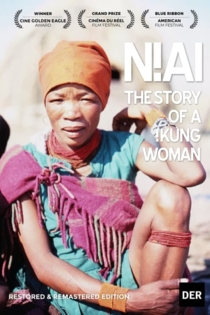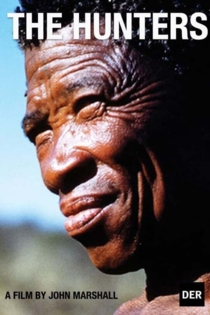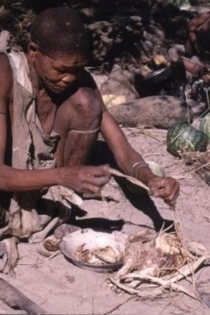
John Marshall
1932 - 2005Marshall first traveled to the Kalahari Desert and met the Ju/'hoansi of the Nyae Nyae area in 1949 on a trip initiated by his father. Throughout the 1950s and 1960's members of the Marshall family returned to the Kalahari Desert numerous times to conduct an ethnographic study of the Ju/'hoansi. From 1950-1958 Marshall filmed the hunting and gathering life of the Ju/'hoansi. His first edited film, The Hunters, was released in 1957 and was an almost instant classic of ethnographic film.
During the 1960s and 1970s, Marshall produced many short films about the Ju/'hoansi of Nyae Nyae and pursued other film projects in the United States. He was the cinematographer and co-director for Fred Wiseman's first documentary film, Titicut Follies. In 1968-1969, he shot, edited and directed the ground-breaking Pittsburgh Police series of short films. In 1968, Marshall and Tim Asch founded Documentary Educational Resources, a non-profit organization dedicated to facilitating the use of cross-cultural documentaries in the classroom.
Marshall became involved in grassroots organizing and development in Nyae Nyae in the 1980s, forming a foundation that would become the Nyae Nyae Development Foundation of Namibia and devoting himself to advocating on behalf of the Ju/'hoansi. In 2003, the Society for Visual Anthropology bestowed on Marshall a lifetime achievement award for his work among the hunter gatherer society.
Marshall's documentary footage and edited films and videos of Ju/'hoansi are held at the Human Studies Film Archives, Smithsonian Institution. Known officially as the John Marshall Ju/'hoan Bushman Film and Video Collection, 1950–2000, the collection was added to UNESCO's Memory of the World Register for documentary heritage of world importance in July 2009.
N/um Tchai: The Ceremonial Dance of the !Kung Bushmen
John Marshall
Tchai is the word used by Ju/'hoansi to describe getting together to dance and sing; n/um can be translated as medicine, or supernatural potency. In the 1950's, when this film was shot, Ju/'hoansi gathered for "medicine dances" often, usually at night, and sometimes such dances lasted until dawn.
N/um Tchai: The Ceremonial Dance of the !Kung Bushmen

N!ai, The Story of a !Kung Woman
John Marshall, Adrienne Miesmer
This film provides a broad overview of Ju/'hoan life, both past and present, and an intimate portrait of N!ai, a Ju/'hoan woman who in 1978 was in her mid-thirties. N!ai tells her own story, and in so doing, the story of Ju/'hoan life over a thirty year period. "Before the white people came we did what we wanted," N!ai recalls, describing the life she remembers as a child: following her mother to pick berries, roots, and nuts as the season changed; the division of giraffe meat; the kinds of rain; her resistance to her marriage to /Gunda at the age of eight; and her changing feelings about her husband when he becomes a healer. As N!ai speaks, the film presents scenes from the 1950's that show her as a young girl and a young wife. The uniqueness of N!ai may lie in its tight integration of ethnography and history. While it portrays the changes in Ju/'hoan society over thirty years, it never loses sight of the individual, N!ai.
N!ai, The Story of a !Kung Woman

The Hunters
John Marshall, Robert Gardner
John Marshall
An ethnographic film that documents the efforts of four !Kung men (also known as Ju/'hoansi or Bushmen) to hunt a giraffe in the Kalahari Desert of Namibia. The footage was shot by John Marshall during a Smithsonian-Harvard Peabody sponsored expedition in 1952–53. In addition to the giraffe hunt, the film shows other aspects of !Kung life at that time, including family relationships, socializing and storytelling, and the hard work of gathering plant foods and hunting for small game.
The Hunters

Inside Outside Station 9
John Marshall
An installment in the Pittsburgh Police series. A number of short sequences show some of the events and people in the daily lives of several policemen: their intervention in domestic quarrels, the handling of a hit-and-run case, the approaches taken toward loitering youths, a drunk and disorderly charge being made in Magistrate's Court, and the interrogation of a burglary suspect. Police force candidates are shown being interviewed by members of the police department. They discuss their reasons for wanting to be policemen and their thoughts about themselves and their jobs, placing the film in the context of the community from which the department draws its personnel.
Inside Outside Station 9

A Group of Women
John Marshall
Ju/'hoan women often share an intimate sociability and spend many hours together discussing their lives, enjoying each other's company and children. In this short film, Ju/'hoan women rest, talk and nurse their babies while lying in the shade of a baobab tree. This film is a good illustration of "collective mothering" in which several women support each other and share the nurturing role.
A Group of Women

A Rite of Passage
John Marshall
This film, shot in 1952-53, documents the scarification ceremony called "marking" which was traditionally held for Ju/'hoan boys after they had killed their first large animal. Here, /Ti!kay, a boy of thirteen, shoots his first wildebeest with an arrow. /Ti!kay's father, Kan//a, and Crooked /Qui help the young hunter track, skin, and butcher the animal. After the meat is brought back to the village, a scarification ceremony takes place, symbolizing the importance of hunting and /Ti!kay's passage into social manhood. He is now considered an acceptable son-in-law by the parents of the girl to whom he has long been betrothed.
A Rite of Passage

If It Fits
John Marshall, Mark Erder
The once thriving industrial town of Haverhill, Massachusetts on the Merrimack River now resembles, in the words of one of the film's subjects, "a ghost town where you expect to see tumbleweeds come rolling down Main Street." This film examines a dying industrial town and its politicians' search for votes over such issues as municipal spending, rising taxes, the revitalization of depressed areas, and attracting new industry. The film's central event is the 1976 Mayoral election. Election scenes are intercut with comments from Haverhill residents, members of a local foundation, political scientist Frances Fox Piven, the president of the local union, and the shoe manufacturers themselves. The oral history which surrounds the election footage is a reservoir of information about Haverhill's present condition as well as its past.
If It Fits

Men Bathing
John Marshall
In Nyae Nyae, water often remains in open pans. Sometimes if the rains have been heavy, water stays in these pans, like small lakes, all year. In this film five Ju/'hoan men visit Nama pan. /Ti!kay washes the clothes he acquired on his trip to rescue his band's wives from a farm (as shown in An Argument About a Marriage). The other men bathe. The men use the opportunity to exchange sexual jokes with pleasure and hilarity. This film provides an interesting comparison with A Group of Women.
Men Bathing

A Joking Relationship
John Marshall
This film depicts a moment of flirtation between N!ai, the young wife of /Gunda, and her great-uncle /Ti!kay. The two share a "joking relationship," a Ju/'hoan kin relationship which provides opportunities for casual intimacy, emotional release, and support.
A Joking Relationship

Playing with Scorpions
John Marshall
Between 1950 and 1958, John Marshall made four expeditions to film the Ju/'hoansi (a group of !Kung Bushmen) of the Nyae Nyae region of Namibia (then South West Africa). During this time, Marshall shot over 300,000 feet of 16mm film (157 hours). He later produced a total of 23 films exclusively from this footage. In this short film, children tempt fate by playing with scorpions.
Playing with Scorpions

Inside/Outside Station Nine
John Marshall
Pioneering ethnographic filmmaker John Marshall casts an eye on the inner workings of a Pittsburgh police station, capturing law enforcement’s day-to-day handling of domestic disturbances, juvenile delinquency, suspect interrogation, and various cases to arrive at a sociological, vérité examination of civil liberties and the carriage of justice.
Inside/Outside Station Nine

